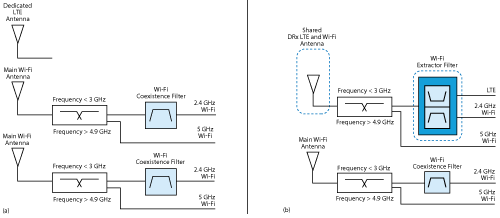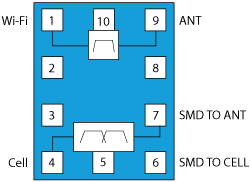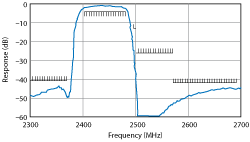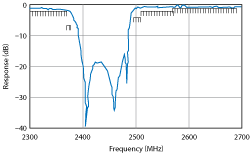In smartphones, high performance Wi-Fi is key to satisfying the ever-growing demand for mobile data, because Wi-Fi offloads traffic from operators’ LTE networks. Trends in 2017 will include the growing prevalence of 2×2 multiple-input-multiple-output (MIMO) in handsets, which enables dual simultaneous data streams. IEEE 802.11ac, which utilizes the 5 GHz band and offers greater throughput than its predecessors, will continue to proliferate, while the industry prepares for the next standard, 802.11ax, which will further improve performance.

Figure 1 Simplified smartphone architecture with 2×2 MIMO Wi-Fi and separate LTE antenna (a) and shared Wi-Fi/LTE antenna (b).

Figure 2 A diplexer module enables Wi-Fi and LTE to share a common antenna (e.g., Qorvo’s 885060).
The drive to continually increase Wi-Fi performance creates design engineering challenges requiring the use of advanced RF filters, typically incorporated into integrated modules to maximize performance, simplify design and save space. One of these challenges is antenna sharing, which facilitates the addition of 2×2 MIMO Wi-Fi alongside increasingly complex LTE functionality in the limited space available within the handset. Other challenges: Designs must avoid interference with neighboring LTE bands, including bands that use the new Class 2 standard for higher output power, and support simultaneous dual-band Wi-Fi operation.
ANTENNA SHARING
The number of antennas in smartphones has grown to support faster data services as well as a growing range of RF technologies. Today’s handsets may require as many as six or seven antennas for primary cellular and diversity receive (DRx), Wi-Fi, near-field communications (NFC) and other technologies. It becomes increasingly difficult to squeeze still more antennas into the limited physical space available within a typical high performance smartphone. Antenna sharing alleviates this problem (see Figure 1), as it allows handsets to accommodate 2×2 MIMO Wi-Fi by sharing the cellular DRx antenna between Wi-Fi and LTE.

Figure 3 Response of the Wi-Fi bandpass filter in the diplexer module.
Antenna sharing requires two advanced filters to avoid interference between 2.4 GHz Wi-Fi and adjacent LTE bands (7, 38, 40 and 41), while diplexing the LTE and Wi-Fi paths to a single antenna port. A 2.4 GHz notch filter is used to remove the Wi-Fi signal from the LTE path, while a 2.4 GHz bandpass filter removes LTE interference from the Wi-Fi path. The use of temperature-compensated bulk acoustic wave (BAW) filters enables designs to minimize insertion loss, meet attenuation requirements for Wi-Fi and LTE, use the full Wi-Fi spectrum and operate across temperature.
One example of a commercial product is Qorvo’s 885060 Wi-Fi extractor filter module (see Figure 2), which combines the notch and bandpass filter into a single module and reduces the need for external matching. The BAW bandpass filter provides high performance Wi-Fi and meets out-of-band attenuation requirements (see Figure 3). The notch filter meets the Wi-Fi attenuation requirements and achieves low insertion loss for the adjacent LTE bands (see Figure 4).

Figure 4 Response of the Wi-Fi notch filter, including the adjacent LTE bands.
LTE POWER STANDARD
Whether or not the handset uses antenna sharing, all handsets require filters to ensure coexistence between 2.4 GHz Wi-Fi and the adjacent LTE bands. A new coexistence challenge is presented by Power Class 2, an emerging standard for higher output power in TD-LTE band 41 (2.5 GHz) and potentially other high frequency bands. Band 41 is increasingly being used in the United States, China and other countries. Power Class 2 increases handset output power to 26 dBm, double the previous 23 dBm maximum defined by power class 3. The goal of increased output power is to compensate for greater propagation losses at higher frequencies. Raising handset output power enables carriers to maintain cell coverage without adding expensive infrastructure.
The filtering challenge is to attenuate these higher power LTE signals sufficiently to protect the neighboring 2.4 GHz Wi-Fi spectrum. The Wi-Fi filter that is required will depend on the filter that the handset manufacturer chooses for band 41. If a high performance filter is used for band 41, the Wi-Fi attenuation requirements will be less stringent; however, if a lower performance filter is used, greater attenuation will be required to avoid interference, meaning a higher performance Wi-Fi filter will be needed.

Figure 5 Evolving Wi-Fi standards.
CONCURRENT DUAL-BAND OPERATION
Another emerging Wi-Fi filtering challenge is presented by the trend toward concurrent dual-band operation. Today’s handsets support both 802.11ac (5 GHz) and the older Wi-Fi standards that use 2.4 GHz (802.11n, b and g). As Wi-Fi becomes more prevalent and is incorporated into more households, wearables and other devices, it will be valuable for a handset to simultaneously communicate on both Wi-Fi bands. The 5 GHz band provides the highest performance, so it may be used for internet access via a local, high bandwidth access point. The 2.4 GHz band will be used because it provides greater range and enables communication with devices that support only the 2.4 GHz band. Wi-Fi filters need to support this concurrent usage, ensuring adequate attenuation of 2.4 GHz signals in the 5 GHz band and vice versa.
Wi-Fi filters are being incorporated into integrated front-end modules (iFEM) with other components in the Wi-Fi transmission chain, such as power amplifiers and switches. Modules provide better performance, reducing matching losses, simplify design complexity, save space, limit the number of discrete components and reduce time to market for the handset manufacturers.
CONCLUSION
Advanced filters and iFEMS are essential components, needed to enable future Wi-Fi performance improvements. 2×2 MIMO in handsets will increase during 2017, particularly among the fast-growing manufacturers in China. This will drive adoption of iFEMs and antenna sharing, as manufacturers seek to add a second Wi-Fi RF chain within the limited space available in increasingly complex handsets.
The upcoming 802.11ax standard will further improve throughput, especially in dense user environments such as stadiums and airports (see Figure 5). Performance improvements will be achieved, in part, by using more complex modulation coding (i.e., 1024-QAM compared with the 256-QAM maximum in 802.11ac), which will tighten the error vector magnitude (EVM) specification from 1 percent to 0.5 percent. To support 802.11ax, Wi-Fi iFEMs will need to improve linearity without sacrificing filter performance.
